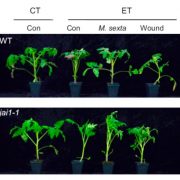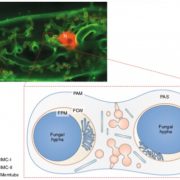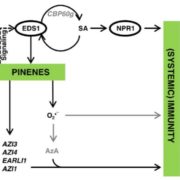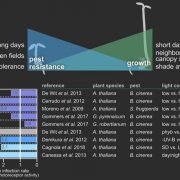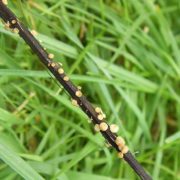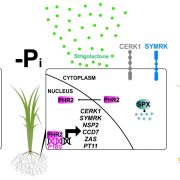Wheat microbiome bacteria reduce virulence of pathogenic fungus by altering fungal histone acetylation (Nature Comms)
 Sometimes the plant is a relatively passive host upon which other organisms engage in dynamic interactions. Chen et al. showed that a wheat head-associated bacterium, Pseudomonas piscium, produces antifungal compounds that inhibit the growth of a plant pathogenic fungus, Fusarium graminearum. The authors started by culturing more than 12,000 bacterial isolates, from which they found that the P. piscium acts as a bacterial biocontrol agent against the fungus. They identified the antifungal compound to be phenazine-1-carboxamide (PCN); deletion of this biosynthetic pathway eliminated the biocontrol effect. By surveying F. graminearum deletion mutants, they found a strain resistant to PCN, and showed that PCN targets a fungal histone acetylase. Interestingly, genetic deletion of this histone acetylase similarly reduced the fungal virulence. These insights can help protect grain crops from this detrimental fungal pathogen. (Summary by Mary Williams) Nature Comms. 10.1038/s41467-018-05683-7
Sometimes the plant is a relatively passive host upon which other organisms engage in dynamic interactions. Chen et al. showed that a wheat head-associated bacterium, Pseudomonas piscium, produces antifungal compounds that inhibit the growth of a plant pathogenic fungus, Fusarium graminearum. The authors started by culturing more than 12,000 bacterial isolates, from which they found that the P. piscium acts as a bacterial biocontrol agent against the fungus. They identified the antifungal compound to be phenazine-1-carboxamide (PCN); deletion of this biosynthetic pathway eliminated the biocontrol effect. By surveying F. graminearum deletion mutants, they found a strain resistant to PCN, and showed that PCN targets a fungal histone acetylase. Interestingly, genetic deletion of this histone acetylase similarly reduced the fungal virulence. These insights can help protect grain crops from this detrimental fungal pathogen. (Summary by Mary Williams) Nature Comms. 10.1038/s41467-018-05683-7


